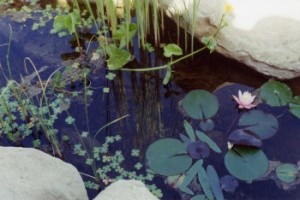





Small water features are always more difficult to keep clear than large ponds. With a small volume of water, rapid temperature change leads to the growth of algae and oxygen depletion, and in winter it is difficult to sustain a balance of life. Water quality depends on a balanced environment, which is impossible to achieve in anything less than a modest garden pool.
 Discolouration of the water, other than from algae, is usually a physical indication that something has gone badly wrong. Perhaps there is a dead and rotting fish or plant, or growing medium has spilled or leached into the water.
Discolouration of the water, other than from algae, is usually a physical indication that something has gone badly wrong. Perhaps there is a dead and rotting fish or plant, or growing medium has spilled or leached into the water.
In all small water features green water will appear from time to time.
The first thing to do to reduce its occurrence is to select your medium very carefully. A compost that is high in readily soluble nutrients will create nightmare green conditions, so avoid using ordinary garden compost at all cost.
Properly formulated aquatic compost contains a minimum of soluble fertiliser and plants depend upon regular feeding with a tablet form of slow-release fertiliser that is manufactured for the precise requirements of aquatic plants. If submerged and floating plants are the only aquatics grown, you can use washed fine gravel and the container can remain soilless. If one or two fish can be included they will provide sufficient detritus, along with the natural plant detritus, for the nourishment of the plants.
Although it is true that a permanent natural balance cannot be achieved in a small water feature, submerged plants can make some difference. As well as being oxygenators, they mop up excess nutrients which are then not available for algal growth, and this helps to keep the water clear.
Without a natural balance, the only reliable way to keep the water clear is by the use of algicides. These are particularly effective with suspended algae — some simply kill them, others cause the algae and other organic detritus to form a mat and settle on the floor of the container. The range of algicides available is huge and, provided that they are used exactly as prescribed on the packaging, neither plants, fish, nor snails will suffer.
Filamentous algae presents a different problem. This is variously known as silkweed, blanket weed or flannel weed, and it can only be successfully removed by hand. An algicide will kill it, but you still need to remove it in order to prevent it from de-oxygenating the water when decomposing. The regular removal of filamentous algae should therefore be part of routine maintenance.
Dirty water resulting from other causes usually means that the feature has to be emptied and cleaned. This is very simple if the death of a fish or plant has caused the pollution, but it can be a little more troublesome to prevent soil or compost spillage recurring.
When planted areas are clearly defined, topdressing the compost with a shallow layer of fine gravel will prevent soil from escaping into the water and deter fish from stirring up the soil. When this is not practical, use a piece of old tights, fill it with soil and mould it to the shape of the planting pocket; the fabric retains all but the finest particles of soil. You can insert the plants through holes that are just large enough to accommodate them, and the roots will bind the whole package together, preventing spillage.
Copyright © www.100flowers.win Botanic Garden All Rights Reserved